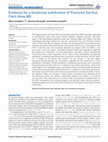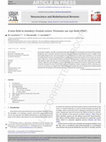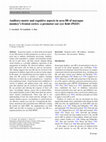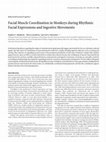Papers by MARCO LANZILOTTO

The Supplementary Eye Field (SEF) and the Frontal Eye Field (FEF) have been described as particip... more The Supplementary Eye Field (SEF) and the Frontal Eye Field (FEF) have been described as participating in gaze shift control. Recent evidence suggests, however, that other areas of the dorsomedial prefrontal cortex also influence gaze shift. Herein, we have investigated electrically evoked ear- and eye movements from the Premotor Ear-Eye Field, or PEEF (area 8B) of macaque monkeys. We stimulated PEEF during spontaneous condition (outside the task performance) and during the execution of a visual fixation task (VFT). In the first case, we functionally identified two regions within the PEEF: a core and a belt. In the core region, stimulation elicited forward ear movements; regarding the evoked eye movements, in some penetrations, stimulation elicited contraversive fixed-vectors with a mean amplitude of 5.14°; while in other penetrations, we observed prevalently contralateral goal-directed eye movements having end-points that fell within 15° in respect to the primary eye position. On the contrary, in the belt region, stimulation elicited backward ear movements; regarding the eye movements, in some penetrations stimulation elicited prevalently contralateral goal-directed eye movements having end-points that fell within 15° in respect to the primary eye position, while in the lateral edge of the investigated region, stimulation elicited contralateral goal-directed eye movements having end-points that fell beyond 15° in respect to the primary eye position. Stimulation during VFT either did not elicit eye movements or evoked saccades of only a few degrees. Finally, even though no head rotation movements were observed during the stimulation period, we viewed a relationship between the duration of stimulation and the neck forces exerted by the monkey's head. We propose an updated vision of the PEEF composed of two functional regions, core and belt, which may be involved in integrating auditory and visual information important to the programming of gaze orienting movements.
The effect of intracortical microstimulation has been studied in several cortical areas from moto... more The effect of intracortical microstimulation has been studied in several cortical areas from motor to sensory areas. The frontal pole has received particular attention, and several microstimulation studies have been conducted in the frontal eye field, supplementary eye field, and the premotor ear-eye field, but no microstimulation studies concerning area 9 are currently available in the literature. In the present study, to fill up this gap, electrical microstimulation was applied to area 9 in two macaque monkeys using long-train pulses of 500-700-800 and 1,000 ms, during two different experimental conditions: a spontaneous condition, while the animals were not actively fixating on a visual target, and during a visual fixation task.

In macaque monkey, area 8B is cytoarchitectonically considered a transitional area between the gr... more In macaque monkey, area 8B is cytoarchitectonically considered a transitional area between the granular Brodmann area 9, rostrally, and the rostral part of the dorsal agranular Brodmann area 6, caudally. As for electrophysiological data, microstimulation of area 8B evokes ear and/or eye movements; unit activity recording shows neurons encoding different auditory environmental stimuli and ear and/or eye movements. Moreover, visual attentive fixation modulates the discharge of auditory environmental neurons and auditory-motor neurons. As for anatomical data, area 8B is connected with auditory cortical areas, superior colliculus and cerebellum. Current functional and anatomical evidences support that area 8B is a specific Premotor Ear-Eye Field (PEEF) involved in auditory stimuli recognition and in orienting processes. In conclusion, we suggest that PEEF could play an important role in engaging the auditory spatial attention for the purpose of orienting eye and ear towards the sound source.

Experimental Brain Research, Jan 1, 2008
In previous reports, we showed the involvement of area 8B neurons in both spontaneous ear and eye... more In previous reports, we showed the involvement of area 8B neurons in both spontaneous ear and eye movement and in auditory information processing. Auditionrelated cells responded to complex environmental stimuli, but not to pure tones, and their activity changed during visual Wxation as a possible inhibitory expression of the engagement of attention. We observed auditory, auditorymotor and motor cells for both eye and ear movements. This Wnding suggests that area 8B may be involved in the integration of auditory input with ear and eye motor output. In this paper, we extended these previous studies by examining area 8B activity in relation to auditive orienting behaviour, as well as the ocular orientation (i.e., visual Wxation) studied previously. Visual Wxation led to inhibition of activity in auditory and auditory-motor cells, which suggests that attention may be involved in both, maintaining the eye position and reducing the response of these cell types. Accordingly, during a given task or natural behaviour, spatial attention seems to aVect more than one sensorimotor channel simultaneously. These data add to our understanding of how the neural network, through a twochannel attentive process, accomplishes to switch between two eVectors, namely eyes and ears. Considering the functional, anatomical and cytoarchitectonic diVerences among the frontal eye Weld (FEF), the supplementary eye Weld (SEF) and area 8B, we propose to consider area 8B as a separate premotor ear-eye Weld (PEEF).

The Journal of …, Jan 1, 2012
Evolutionary hypotheses regarding the origins of communication signals generally suggest, particu... more Evolutionary hypotheses regarding the origins of communication signals generally suggest, particularly for the case of primate orofacial signals, that they derive by ritualization of noncommunicative behaviors, notably including ingestive behaviors such as chewing and nursing. These theories are appealing in part because of the prominent periodicities in both types of behavior. Despite their intuitive appeal, however, there are little or no data with which to evaluate these theories because the coordination of muscles innervated by the facial nucleus has not been carefully compared between communicative and ingestive movements. Such data are especially crucial for reconciling neurophysiological assumptions regarding facial motor control in communication and ingestion. We here address this gap by contrasting the coordination of facial muscles during different types of rhythmic orofacial behavior in macaque monkeys, finding that the perioral muscles innervated by the facial nucleus are rhythmically coordinated during lipsmacks and that this coordination appears distinct from that observed during ingestion.
Neuroscience Letters, Jan 1, 2011
researchgate.net
In macaque monkeys, area 8B may be considered cytoarchitectonically as a transitional area betwee... more In macaque monkeys, area 8B may be considered cytoarchitectonically as a transitional area between the granular area 9, rostrally, and the rostral part of the dorsal agranular area 6 (FC or F7), caudally. This area is anatomically connected with auditory cortical areas, cerebellum and superior colliculus. Microstimulation of area 8B evokes ear movements or eye movements in some sites; in other sites, it evokes both ear and eye movements by varying the intensity of electric stimulation. Unit activity recording shows that neurons in area 8B have a role in encoding different auditory environmental stimuli and movements of the ear and eye. In addition, fixation of a visual stimulus, when attention is engaged, modulates the discharge of auditory environmental neurons, and sensory-motor neurons.



Uploads
Papers by MARCO LANZILOTTO